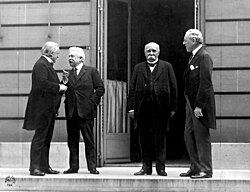World War II/Treaty of Versailles
World War I
[edit | edit source]Before one can understand why World War II happened, they must first understand why World War I happened.

Prelude
[edit | edit source]On June 28th, 1914, the heir to the throne of Austria-Hungary was assassinated by Serbian terrorists. Austria quickly deemed Serbia responsible and demanded retaliation. At this time, Europe was a tangle of secret alliances between major powers. France and Russia supported Serbia while Germany supported Austria-Hungary. On July 23, 1914, an ultimatum was sent to Serbia with ten demands, some so extreme that the Serbian reply included reservations and rejected the sixth demand. The Serbians, relying on support from Russia, removed acceptance of the sixth key demand (the draft reply had accepted it), and also ordered mobilization. In response to this, Austria-Hungary issued a declaration of war on July 28. Russia began to mobilize, and after denying a German request to stop, Germany declared war on Russia. Germany was sure that France would come to the support of Russia, so they also declared war on France.
Initially, Britain remained neutral but when German invaded Belgium in order to execute the Schlieffen Plan, Britain was drawn into the war.
Central Powers Success
[edit | edit source]The war on the Western Front drew into a stalemate, as both sides dug trenches through Western France and suffered heavy casualties only to advance a few miles and be pushed back. On the Eastern Front, a seesaw war ensued, with both sides attacking, advancing then retreating. In 1915 Bulgaria and the Ottoman Empire came onto the side of Germany and Austria-Hungary, collectively known as the Central Powers. Italy joined the Allied side in 1915, with the promise of territorial expansion. In 1915, Bulgaria and Austria-Hungary conquered Serbia and Montenegro. They pushed to the Greek border. Several attempts by the Ottoman Empire to seize the Suez Canal from the British failed, and an Ottoman offensive into Russia proved to be a catastrophe. The greatest allies success came in the German colonies, which were seized by the Japanese and the British.

Turning the Tide
[edit | edit source]In 1917 Russia was forced out of the war after the Tsar was overthrown. However, the United States entered the war on the side of the allies. Germany realized that its only chance to win the war was to push to Paris before American troops arrived. After initial success, the offensive stalled and when American troops began to arrive, Germany suffered major defeats. Germany's allies began to collapse as well. After an Allied breakthrough in Macedonia, Bulgaria surrendered on September 29, 1918. After the fall of Baghdad and Jerusalem, the Ottomans surrendered on October 30. An Italian breakthrough into Austria-Hungary resulted in their surrender on November 4. Germany agreed to a cease-fire on November 11.
The Treaty
[edit | edit source]Negotiations between the Allied powers started on January 18 in the Salle de l'Horloge at the French Foreign Ministry, on the Quai d'Orsay in Paris. Initially, 70 delegates of 26 nations participated in the negotiations. Having been defeated, Germany, Austria, and Hungary were excluded from the negotiations. Russia was also excluded because it had negotiated a separate peace with Germany in 1917, in which Germany gained a large fraction of Russia's land and resources.
French Aims
[edit | edit source]France had lost some 1.5 million military personnel and an estimated 400,000 civilians to the war, and much of the western front had been fought on French soil. To appease the French public, Prime Minister Georges Clemenceau wanted to impose policies deliberately meant to cripple Germany militarily, politically, and economically so as never to be able to invade France again.
British Aims
[edit | edit source]Prime Minister David Lloyd George supported reparations but to a lesser extent than the French. Lloyd George was aware that if the demands made by France were carried out, France could become the most powerful force on the continent, and a delicate balance could be unsettled. Lloyd George was also worried by Woodrow Wilson's proposal for "self-determination" and, like the French, wanted to preserve his own nation's empire. Like the French, Lloyd George also supported secret treaties and naval blockades.

American Aims
[edit | edit source]The United States took a more conciliatory view toward the issue of German reparations. American Leaders wanted to ensure the success of future trading opportunities and favorably collect on the European debt, and hoped to avoid future wars. Before the end of the war, President Woodrow Wilson, along with other American officials including Edward Mandell House, put forward his Fourteen Points which he presented in a speech at the Paris Peace Conference.
Results
[edit | edit source]The treaty was signed on June 28, 1919. It said that Germany was solely responsible for the war, and the size of the military was greatly reduced. Germany was not allowed to have an airforce.
Germany was compelled to yield control of its colonies, and would also lose a number of European territories. Most notably, the province of West Prussia would be ceded to the newly independent Second Polish Republic, thereby granting Poland access to the Baltic Sea via the "Polish Corridor", and turning East Prussia into an exclave, separated from mainland Germany.

In Europe, Germany lost Alsace-Lorraine to France, Northern Schleswig to Denmark, the Prussian provinces of Posen and of West Prussia to Poland and a small amount of territory to Belgium. In addition, the Province of Saar would be under control of the League of Nations for 15 years, and the Rhineland demilitarized. The total sum of war reparations demanded from Germany—226 billion Reichsmarks in gold (around £11.3 billion)—was decided by an Inter-Allied Reparations Commission. In 1921, it was reduced to 132 billion Reichsmarks (£4,990 million).
